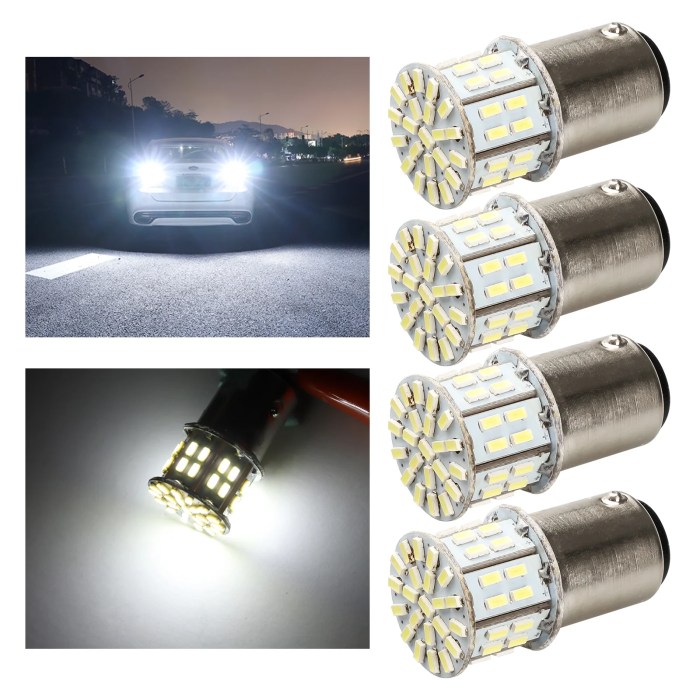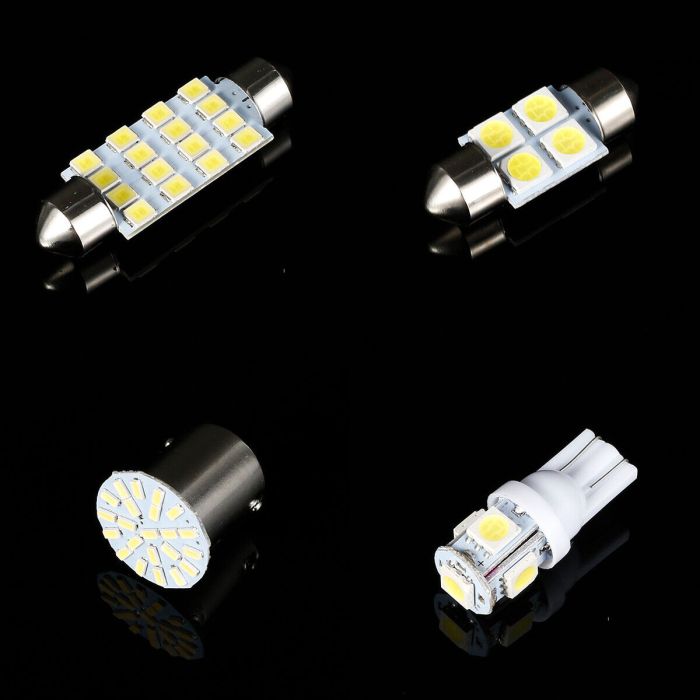Cheap LED interior bulbs for cars are transforming how we illuminate our vehicles. Forget those dim, energy-guzzling incandescent bulbs; LEDs offer a brighter, more efficient, and stylish upgrade. This guide dives into everything you need to know about finding, installing, and enjoying the benefits of these affordable lighting solutions, from understanding different bulb types and compatibility issues to assessing long-term cost savings and safety considerations.
We’ll cover various LED types like festoon, wedge, and dome, detailing their wattage, lumen output, and lifespan compared to traditional bulbs. We’ll walk you through a simple installation process, highlighting potential compatibility problems and how to troubleshoot them. Plus, we’ll explore the cost-effectiveness of switching to LEDs, analyzing the return on investment and addressing potential quality concerns. Finally, we’ll touch on safety regulations and environmental impacts to ensure you’re making an informed and responsible choice.
Product Overview
So you’re looking to upgrade your car’s interior lighting, but don’t want to break the bank? Cheap LED interior car bulbs offer a great balance of affordability and improved illumination compared to traditional incandescent bulbs. This overview will explore the different types available, their specifications, and what you can expect in terms of performance and longevity.
The market offers a wide variety of inexpensive LED bulbs designed for automotive interior use. These are generally plug-and-play replacements for your existing bulbs, offering a simple upgrade path. Understanding the different types and their characteristics is key to choosing the right ones for your vehicle.
LED Interior Car Bulb Types
Several common types of LED bulbs cater to various interior lighting applications in cars. The choice depends on the socket type in your vehicle’s fixtures. Below is a table summarizing the key differences:
| Type | Features | Advantages | Disadvantages |
|---|---|---|---|
| Wedge (e.g., 194, 168, 2825) | Small, wedge-shaped base; various sizes; often used for map lights, courtesy lights, and license plate lights. | Easy to install; widely available; relatively inexpensive. | Can be prone to overheating if not properly ventilated; may have slightly less intense light output compared to other types for the same wattage. |
| Festoon (e.g., 31mm, 39mm, 41mm) | Elongated, cylindrical shape with two contacts at each end; commonly used for dome lights and trunk lights. | Offers brighter, more even light distribution than wedge bulbs in dome applications; various sizes available to fit different fixtures. | May require slightly more careful installation; size must match existing fixture exactly. |
| Dome (various sizes and shapes) | Larger bulbs, often with multiple LEDs; typically used for overhead dome lights. | Bright, wide illumination; some offer multiple brightness settings or color options. | Can be more expensive than wedge or festoon bulbs; may require more space within the fixture. |
| Bayonet (e.g., BA9s, BA15s) | Features a bayonet mount for secure connection; commonly found in dashboard lights and instrument cluster lighting. | Generally more durable and secure than wedge or festoon types; provide focused light. | May require slightly more technical knowledge for installation; less common than wedge or festoon. |
Wattage and Lumen Output
Cheap LED interior car bulbs typically range from 1 to 5 watts in power consumption. Lumen output, a measure of light brightness, varies significantly depending on the bulb’s design and number of LEDs. Expect lumen outputs ranging from 100 to 600 lumens, depending on the bulb type and wattage. A higher wattage generally, but not always, correlates to higher lumen output.
For example, a 3-watt LED bulb might produce around 300 lumens, while a 1-watt bulb might produce only 100 lumens.
Lifespan Comparison, Cheap LED interior bulbs for cars
A significant advantage of LEDs over traditional incandescent bulbs is their significantly longer lifespan. Incandescent bulbs typically last for only a few hundred hours, while cheap LED bulbs can easily last for 50,000 hours or more. This translates to years of use before needing replacement, saving you time and money on bulb replacements. For example, if an incandescent bulb lasts 500 hours and is used for 1 hour per day, it needs replacing roughly every 1.4 years.
A 50,000-hour LED bulb used under the same conditions would last approximately 137 years. This dramatically reduces maintenance and replacement costs over the life of your vehicle.
Installation and Compatibility: Cheap LED Interior Bulbs For Cars
Swapping out your car’s interior lights for LEDs is a pretty straightforward process, but knowing a few key things beforehand can save you some headaches. This section covers the installation steps and some common compatibility snags you might encounter, helping you get those bright new LEDs shining in no time.
Successfully installing your new LED bulbs depends heavily on understanding your car’s lighting system and selecting the right bulbs. Improper installation can lead to blown fuses, malfunctioning lights, or even damage to your car’s electrical system. Therefore, careful preparation and a methodical approach are key.
LED Interior Bulb Installation Guide
Before you start, gather your tools. You’ll likely only need a small flathead screwdriver or your fingers, depending on the bulb type and your car’s design. In some cases, you might need a trim removal tool to avoid scratching your interior panels.
- Turn off your car and let the lights cool down completely. This is a crucial safety step to avoid burns.
- Locate the old bulb. Usually, they’re easily accessible in the overhead console, map lights, or door panels. Consult your car’s owner’s manual if you’re unsure.
- Carefully remove the old bulb. This usually involves twisting the bulb slightly counterclockwise to release it from its socket. Some bulbs might require gently pulling them out. If you encounter resistance, double-check the method described in your car’s manual.
- Compare the new LED bulb to the old one. Ensure they are the same size and shape. If the new LED has a different base type, it won’t fit.
- Insert the new LED bulb into the socket. Gently twist it clockwise to secure it. Make sure it clicks into place.
- Test the new bulb. Turn on the car’s interior lights to ensure the new LED is working correctly.
- Repeat steps 2-6 for all the interior lights you want to replace.
Common Compatibility Issues and Troubleshooting
While LED bulbs are generally easy to install, compatibility issues can arise. These often stem from differences in bulb size, socket type, and electrical characteristics. Here’s a look at some common problems and their solutions.
- Bulb Doesn’t Fit: This is the most frequent issue. Double-check that you purchased the correct bulb type (e.g., T10, 194, Festoon) for your car’s interior lights. Incorrect bulb size prevents installation.
- Bulb Flickers or Doesn’t Turn On: This could be due to a few reasons: incorrect polarity (LEDs have a positive and negative side), low voltage, or a faulty bulb. Try rotating the bulb 180 degrees to reverse the polarity. If the problem persists, try a different bulb.
- Error Messages on Dashboard: Some newer cars have sophisticated systems that detect bulb failures. LEDs might trigger error messages because they draw less power than incandescent bulbs. You may need a CAN-bus decoder to resolve this issue. These small devices prevent error messages by mimicking the power draw of the original bulbs.
- Blown Fuse: Incorrect installation or a faulty bulb can blow a fuse. Check your car’s fuse box (usually located under the dashboard or hood) and replace the blown fuse with one of the correct amperage.
Importance of Checking the Bulb Socket Type
Before purchasing any LED bulbs, verifying the socket type is paramount. Different car models and even different lights within the same car can use different socket types. Ignoring this crucial step almost guarantees incompatibility. The socket type is usually marked on the old bulb or can be found in your car’s owner’s manual. Common socket types include T10, 194, 168, 2825, and Festoon, among others.
Purchasing the wrong type leads to frustration and wasted money.
Cost and Value Analysis

Switching to LED interior car lights might seem like a small upgrade, but considering the long-term costs and benefits reveals a surprisingly smart investment. While the initial purchase price might seem higher than traditional incandescent bulbs, the savings quickly add up, making the switch a financially savvy decision. Let’s break down the cost-effectiveness.
The initial cost of cheap LED bulbs is significantly lower than higher-end LED options or traditional incandescent bulbs. Think of it like this: you can find a basic set of four LED bulbs for under $10, while premium LEDs might cost $20 or more for a similar set. Incandescent bulbs, while initially cheaper per unit, are significantly more expensive in the long run.
So, you’re all about modding your ride, right? Started with cheap LED interior bulbs for cars – major upgrade for like, ten bucks. But to keep things legit, you also need to think about emissions, which is why checking out options like High-flow catalytic converters for emissions compliance is a smart move. Then, after you’ve nailed the performance and legality side of things, you can totally focus back on those sweet LED interior lights.
A visual representation of this would be a bar chart. The chart would show three bars: one for “Cheap LED Bulbs” reaching a height representing a price of approximately $10, another for “Premium LED Bulbs” reaching a height representing approximately $20, and a third bar for “Incandescent Bulbs” showing a price point of roughly $5, but this only represents the initial cost of replacement.
The bar for Incandescent Bulbs is not representative of the overall cost over time.
Initial Cost Comparison
A direct comparison highlights the difference. Let’s say a basic set of four incandescent bulbs costs $5. A comparable set of cheap LED bulbs might cost $10. While the initial investment is double, the long-term savings dramatically outweigh this difference. Premium LED bulbs, while offering features like brighter light or different color temperatures, can cost significantly more, ranging from $20 to $50 or even more, depending on the features and brand.
Long-Term Cost Savings
The real value of cheap LED bulbs lies in their lower energy consumption and longer lifespan. LEDs use significantly less energy than incandescent bulbs, resulting in lower electricity bills. Plus, LEDs last much longer – typically 50,000 hours or more compared to a few thousand hours for incandescent bulbs. This translates to fewer replacements, saving you money and time in the long run.
For example, if you drive frequently, you might replace incandescent bulbs every six months, adding up to a considerable cost over several years. LED bulbs, with their extended lifespan, could last for several years, even with daily use. This reduction in replacement frequency is a significant factor in overall cost savings.
Return on Investment
The return on investment (ROI) for switching to cheap LED bulbs is quite high. The lower energy consumption and extended lifespan quickly offset the slightly higher initial cost. Consider this: even though you pay more upfront for the LED bulbs, the reduced electricity bills and decreased replacement frequency will save you money over the bulbs’ lifespan. This savings represents a significant return on your initial investment.
For instance, if you save $5 per year on electricity and avoid the cost of replacing incandescent bulbs multiple times, the savings accumulate rapidly, resulting in a positive ROI within a short period. The exact ROI will vary based on usage frequency, electricity prices, and the specific cost of the bulbs.
Quality and Durability
So, you’re thinking about upgrading your car’s interior lighting with cheap LED bulbs. Sounds like a great budget-friendly option, right? But before you click “buy,” let’s talk about the potential trade-offs between price and longevity. Cheap LED bulbs might seem appealing upfront, but their quality and durability can significantly impact your overall experience.Cheap LED bulbs often cut corners to achieve a lower price point.
This can manifest in several ways, affecting both their immediate performance and long-term lifespan. Understanding these potential issues is crucial for making an informed decision.
Build Quality and Material Comparison
The most significant difference between cheap and expensive LED bulbs lies in the components and manufacturing processes. Expensive bulbs typically use higher-quality LEDs with better heat dissipation mechanisms, ensuring consistent brightness and a longer lifespan. They often feature robust aluminum or copper heat sinks, whereas cheaper options might use plastic or inferior metals that overheat more easily. The internal circuitry also differs; expensive bulbs usually employ more sophisticated driver circuits that provide stable current and protect the LEDs from voltage fluctuations, while cheaper ones may use simpler, less reliable designs.
This leads to differences in light output, color consistency, and longevity. For example, a high-end bulb might use a ceramic substrate for the LED chip, offering superior heat transfer compared to the plastic substrate found in a cheaper alternative. The lens material also plays a role; high-quality bulbs often use polycarbonate lenses, known for their durability and resistance to yellowing, while cheaper bulbs may use less durable materials prone to cracking or clouding over time.
User Experiences and Durability Issues
Online reviews frequently highlight the shorter lifespan of cheap LED bulbs. Many users report premature failures, flickering, or dimming after only a few months of use. This is often attributed to overheating, caused by inadequate heat dissipation, leading to LED chip degradation. Some reviews also mention inconsistent brightness levels across multiple bulbs in a single set, indicating variations in manufacturing quality.
For instance, a common complaint is that the bulbs burn out unevenly, leaving some brighter than others. Another issue is color inconsistency; cheap bulbs might produce a slightly different shade of white or another color compared to the advertised specifications. These issues are less prevalent with higher-quality, more expensive bulbs, which are designed to withstand the rigors of automotive use and offer consistent performance over a longer period.
While individual experiences can vary, the overall trend suggests that while cheap LED bulbs might offer initial cost savings, the frequent replacements required can negate those savings in the long run.
Safety Considerations
Switching to LED interior car bulbs can be a great upgrade, offering brighter light and lower energy consumption. However, improper installation or faulty bulbs can pose significant safety risks. Understanding these risks and taking the necessary precautions is crucial for a safe and enjoyable driving experience. This section will Artikel potential hazards and steps to mitigate them.Improperly installed or defective LED bulbs can create several hazards.
A loose bulb could vibrate loose and cause a short circuit, potentially damaging your car’s electrical system or even causing a fire. Incorrectly wired bulbs might draw too much power, leading to overheating and melting of nearby components. Additionally, bulbs that don’t meet safety standards might emit electromagnetic interference (EMI), which can disrupt other electronic systems in your vehicle, impacting everything from your radio to your anti-lock brakes (ABS).
Finally, a poorly designed bulb could produce excessive heat, posing a burn risk if touched immediately after use.
Potential Hazards of Improper Installation
Improper installation is a leading cause of LED bulb-related issues. For example, forcing a bulb into a socket that doesn’t fit properly can damage the bulb’s internal components, leading to premature failure or even short circuits. Failing to properly secure the bulb can result in loose connections, which can lead to flickering lights or complete failure. Moreover, incorrect polarity (connecting positive and negative terminals incorrectly) can cause the bulb to malfunction or even damage the vehicle’s electrical system.
Always refer to the bulb’s instructions and your vehicle’s manual for proper installation procedures.
Importance of Safety Standards Compliance
Choosing LED bulbs that meet relevant safety standards is paramount. Look for certifications like CE (Conformité Européenne) or UL (Underwriters Laboratories), which indicate that the bulbs have been tested and meet specific safety requirements. These standards cover aspects like electrical safety, heat resistance, and electromagnetic compatibility. Bulbs lacking these certifications might not meet the same safety standards, increasing the risk of malfunction or hazards.
The cost savings from purchasing uncertified bulbs are significantly outweighed by the potential risks.
Addressing Malfunctioning Bulbs
If a bulb malfunctions, such as flickering, dimming, or failing to illuminate, the first step is to disconnect it immediately to prevent further damage. Do not attempt to repair the bulb yourself unless you have the appropriate expertise. Replace the bulb with a new one, ensuring proper installation according to the manufacturer’s instructions. If the problem persists after replacing the bulb, it may indicate a problem with your vehicle’s electrical system, and professional help from a qualified mechanic should be sought.
Ignoring a malfunctioning bulb can lead to further complications, potentially affecting other electrical components in your car.
Legal and Regulatory Compliance
Using LED bulbs in your car might seem like a simple upgrade, but there are actually some legal hoops to jump through. Different regions have varying regulations regarding automotive lighting, and using non-compliant bulbs can lead to fines or even legal trouble. Understanding these regulations is crucial for safe and legal driving.Replacing your car’s original lighting with aftermarket LED bulbs isn’t as simple as swapping in a new lightbulb.
Many jurisdictions have specific requirements for vehicle lighting, focusing on brightness, color temperature, and beam pattern to ensure road safety. Using bulbs that don’t meet these standards could result in issues during vehicle inspections or even accidents caused by inadequate lighting.
Vehicle Lighting Regulations and Standards
Many countries and states have regulations governing vehicle lighting. These often specify allowable brightness levels (measured in lumens or candela), color temperature (measured in Kelvin), and beam patterns to ensure visibility and prevent glare. For example, some jurisdictions might prohibit excessively bright headlights that could blind oncoming drivers. These regulations are designed to maintain a consistent level of road safety across all vehicles.
Failure to comply could result in fines, vehicle failure to pass inspection, or even more serious consequences in the event of an accident.
So you’re looking for cheap LED interior bulbs for your car? That’s awesome, totally doable on a budget. If you’re feeling ambitious, check out this guide on How to install ambient lighting in car interior to really upgrade your ride. Once you’ve got those sweet LEDs installed, you’ll be cruising in style – and all without breaking the bank!
Certifications and Standards for Automotive LED Bulbs
Several certifications and standards exist to verify that automotive LED bulbs meet safety and performance requirements. These certifications, often marked on the packaging, help consumers identify compliant products. Look for certifications like DOT (Department of Transportation) in the US, or equivalent certifications in other countries. These certifications indicate that the bulbs have undergone testing to ensure they meet specific safety and performance standards.
The absence of such certifications could indicate a higher risk of non-compliance.
Potential Legal Consequences of Using Non-Compliant Bulbs
Driving with non-compliant LED bulbs can lead to various legal consequences, depending on the jurisdiction and the severity of the non-compliance. These consequences can range from warnings and fines to more serious penalties such as vehicle impoundment or even license suspension. In some cases, if a non-compliant bulb contributes to an accident, there could be even more significant legal ramifications.
For instance, a poorly designed or installed LED bulb causing inadequate lighting and leading to a collision could result in legal liability for the driver. Therefore, ensuring compliance with all relevant regulations is paramount.
Environmental Impact

Switching to LED interior car bulbs offers significant environmental advantages over traditional incandescent bulbs. The reduced energy consumption and longer lifespan directly translate into lower greenhouse gas emissions and less waste generated throughout the product lifecycle. However, it’s crucial to consider the environmental impact of manufacturing and disposal of LEDs as well.LEDs boast substantially lower energy consumption compared to incandescent and even halogen bulbs.
This means less electricity is drawn from the power grid, reducing the demand on power plants and subsequently lowering the emissions associated with electricity generation, primarily carbon dioxide. The longer lifespan of LEDs also reduces the frequency of bulb replacements, further minimizing waste and the associated environmental impact of manufacturing and transportation.
LED Manufacturing and Disposal
The manufacturing process of LEDs involves the extraction and processing of various materials, some of which have environmental consequences. The production of semiconductor materials like gallium arsenide and indium phosphide requires significant energy and can generate hazardous waste if not properly managed. Furthermore, the mining of rare earth elements, sometimes used in LED components, raises concerns about habitat destruction and potential pollution.
Responsible disposal of LED bulbs is also important, as they contain small amounts of heavy metals that could contaminate soil and water if not handled properly. Recycling programs are essential to mitigate these environmental concerns.
Environmental Impact Comparison of Bulb Types
The following table compares the environmental impact of incandescent, halogen, and LED car interior bulbs:
| Bulb Type | Energy Efficiency | Lifespan (hours) | Greenhouse Gas Emissions (per unit) | Waste Generation (per unit) |
|---|---|---|---|---|
| Incandescent | Low | 750-1000 | High | High |
| Halogen | Medium | 2000-4000 | Medium | Medium |
| LED | High | 30000-50000+ | Low | Low (with proper recycling) |
Note: The values in the table are relative and can vary depending on specific product specifications, manufacturing processes, and electricity generation methods. For example, the greenhouse gas emissions are highly dependent on the source of electricity used to power the bulbs. A power grid heavily reliant on fossil fuels will result in higher emissions compared to a grid utilizing renewable energy sources.
Similarly, waste generation is minimized with effective recycling programs. The longer lifespan of LEDs significantly reduces the overall environmental impact over their lifetime, even accounting for the initial manufacturing processes.
Closing Summary
Upgrading your car’s interior lighting to cheap LED bulbs is a simple yet impactful modification. From the improved visibility and modern aesthetic to the long-term cost savings and environmental benefits, the advantages are clear. By carefully considering bulb type, compatibility, and safety, you can easily transform your car’s interior with a brighter, more efficient, and budget-friendly upgrade. So, ditch those old bulbs and light up your ride!









